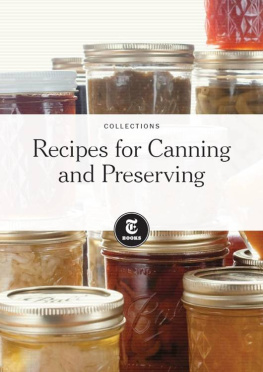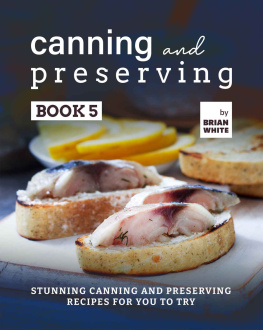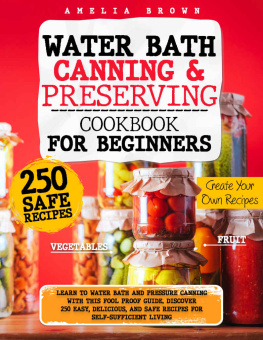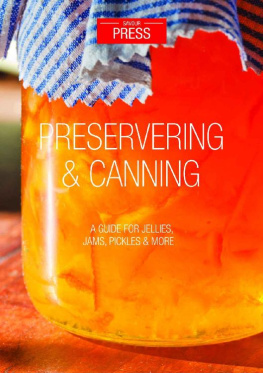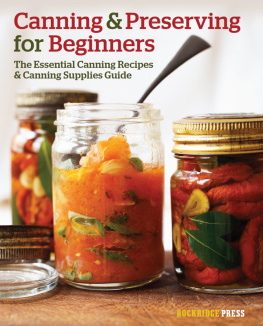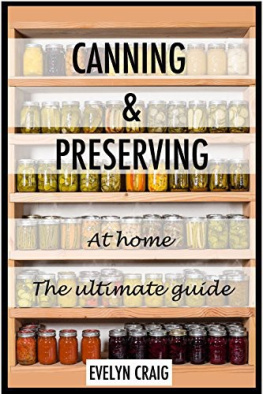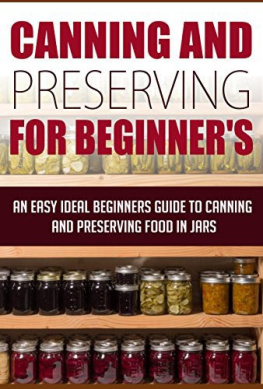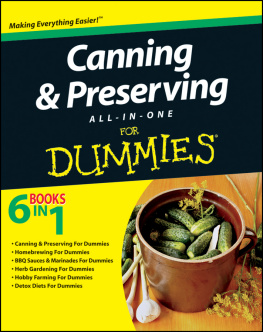Copyright 2015 The New York Times Company. All rights reserved.
This ebook was created using Vook.
Not So Scary: Easy Steps to Canning
By CATHY BARROW
MAY 15, 2012
The fruits and vegetables that seduce us early in the season (asparagus, spring onions, rhubarb and now strawberries) make me greedy. I fall hard and completely, happy to lug home cumbersome bags from the farmers market and create a still life on my kitchen counter of big bunches of vegetables and piles of berries. I want to incorporate all of it into every meal. I want to capture the moment and bottle it.
And now is an excellent time. Perhaps you have made freezer jam or quick refrigerator pickles, those red onions in vinegar, sugar and salt. Im hoping spring will tempt you to try preservation, a fancy word for canning, and like the act itself, not as scary as it sounds.
You probably have most of what you need: a stockpot large enough to cover the jars with at least two inches of water; a heavy-bottomed pot for cooking the jam (enameled cast iron like Le Creuset, copper or stainless steel). Avoid aluminum as it can leach, leaving your preserves or pickles tasting of metal. Rubber-coated jar lifters are nice, but a pair of tongs with rubber bands wrapped around each of the pincers will provide the same security in lifting the hot jars from boiling water. A big stack of clean dish towels completes the must-haves.
You can buy your jars at the hardware store, where they are usually sold in sizes of half-pint, best for jam, or pint, ideal for pickles. Thrift stores and flea markets are great places to find used jars, but check that they are not chipped or cracked. And be sure to use jars that are made for canning, generally marked Ball or Kerr, with flat lids and rings that hold the lids on tight. The jars and rings are reusable, but lids should be new each time you preserve.
Heres how it works: When the filled and closed jars are lowered into a bath of boiling water, the temperatures inside and outside the jars will equalize, bringing the contents of the jar to 212 degrees Fahrenheit and making them safe for shelf storage. The gasket on the underside of each lid forms a seal as the contents come to temperature, and will ping as the suction draws the lid tight.
It is such a satisfying and alluring sound, telling you that you have successfully protected the contents. If you dont hear it, or if the seal otherwise fails, you can simply repeat the process. But you can avoid seal failure by not overfilling the jars and by completely cleaning the rim before placing the lid on top.
Some of the trepidation surrounding canning is about all that boiling water. Does the phrase sterilize the jars strike fear in your heart? Not to worry. Just run them through the dishwasher. If you have no dishwasher or do not trust yours to do the job properly, use that same big stockpot to boil the jars for 10 minutes. You can leave them in the water until it is time to fill them; by then, the water will have cooled a bit and you are less likely to burn yourself.
I use a small saucepan to boil the rings mostly, just to be sure they are clean. Then I add the lids after turning off the heat. (Canners who boil their jars sometimes put the rings into the same pot, then add the lids for just a minute to soften their rubber gaskets.)
Which brings us to the heart of the matter: Many first-timers fear canning because they are afraid they wont know if they have done it safely. They worry they might somehow end up making their families sick. You should take no chances; when in doubt, throw it out.
But you may be reassured to know that sugar and vinegar are natural preservatives and make it less likely that bacteria will grow inside your jars. Mold is a more likely problem, but even that is rare. To be safe, check the seals. Label and date every jar and use what you make within a year.
And follow common sense. There are so many reasons to preserve the best of the season. Your kitchen will smell divine. Your family and friends may want to help. Or you may find solitary work in the kitchen to be an exquisite break from a busy schedule, a chance to listen to music or the ballgame. Veterans extol the meditative nature of an afternoon spent making preserves.
Then theres the joy, months later, when those preserves make an appearance long after the last of the in-season berries were scattered over the morning oatmeal. Your breakfast toast, bagels or biscuits will be much improved. You will want your jam stirred into plain yogurt, rolled into a crepe, spread between layers of a cake or incorporated into a very special P.B. and J.
Those asparagus and spring onions? As pickles, they are an excellent accompaniment to transform a bit of charcuterie or salumi into a memorable antipasto.
And your preserved fruits and vegetables make lovely hostess gifts or party favors if you can bear to part with them.
Strawberry Rhubarb Confiture
By CATHY BARROW
MAY 15, 2012
Here is a delicious introduction to the business of canning, which can seem daunting but is made much easier by the right equipment and a good recipe. Youll combine strawberries, rhubarb vanilla and sugar over heat and then follow standard canning instructions, laid out in the recipes instructions. It all leads up to summer sweetness in a jar that youve made yourself. And dont worry: if your preserves are on the runny side, just call them syrup. No one will mind.
Ingredients:
2 pints (about 2 pounds) fresh strawberries, stemmed and cut into bite-size pieces
2 pounds rhubarb, trimmed and cut into 1/2-inch dice
3 cups sugar
Juice of one lemon
1 vanilla bean
teaspoon butter.
Preparation:
In a large nonreactive bowl, combine the strawberries, rhubarb, sugar and lemon juice. Split the vanilla bean lengthwise and scrape out the pulp. Add the pulp and bean to the bowl. Mix gently but thoroughly. Cover, refrigerate and allow fruit to macerate 6 to 12 hours.
Fit a large pot with a rack or line it with a folded kitchen towel. Fill with water and bring to a boil. Sterilize 6 half-pint canning jars by running them through a dishwasher cycle. If boiling them, add jars to the pot and boil for 10 minutes. The jars may be left in the dishwasher or pot until ready to be filled.
Strain the liquid out of the berry mixture into a heavy-bottomed large pot. Allow liquid to drain for a few minutes, pressing on the fruit. Set the fruit aside. Place the pot over medium-low heat and slowly bring the syrup to 220 degrees Fahrenheit on a candy thermometer, a strong boil that wont stir down. If your pan is broad and the syrup is not very deep, tilt the pan frequently and place the candy thermometer deep into the syrup, to measure the temperature more effectively. This could take about 45 minutes. Stir frequently.
Place the canning rings in a small saucepan, cover with water and bring to a boil. Turn off the heat and add the lids to soften the rubber gaskets.
Remove the vanilla bean from the fruit and stir the fruit into the syrup. The boiling will slow, but will come back quickly. Watch the bubbles in the boil as you stir. Foam will form because the water in the fruit is drawn out, to be replaced with the syrup. In about 10 minutes, when the confiture is almost ready, the foam will begin to dissipate, the bubbles breaking more slowly and exposing a clear syrup below.

